Publications
-
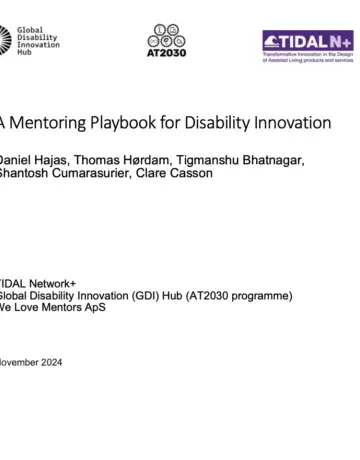
A Mentoring Playbook for Disability Innovation
Daniel Hajas, Thomas Hørdam, Tigmanshu Bhatnagar, Shantosh Cumarasurier, Clare CassonNov. 1, 2024AT2030 ResourcesThis playbook provides a comprehensive guide for organisations seeking to launch and manage mentoring programmes aimed at early career researchers (ECRs) and start-ups in the disability innovation sector. Rooted in the experiences of the TIDAL ECR Accelerator, insights from the Attvaran Accelerator, run by GDI Hub as part of the AT2030 programme, and We Love Mentors, this playbook outlines a practical and adaptable framework for fostering mentoring in a complex, yet essential, area of innovation.
-
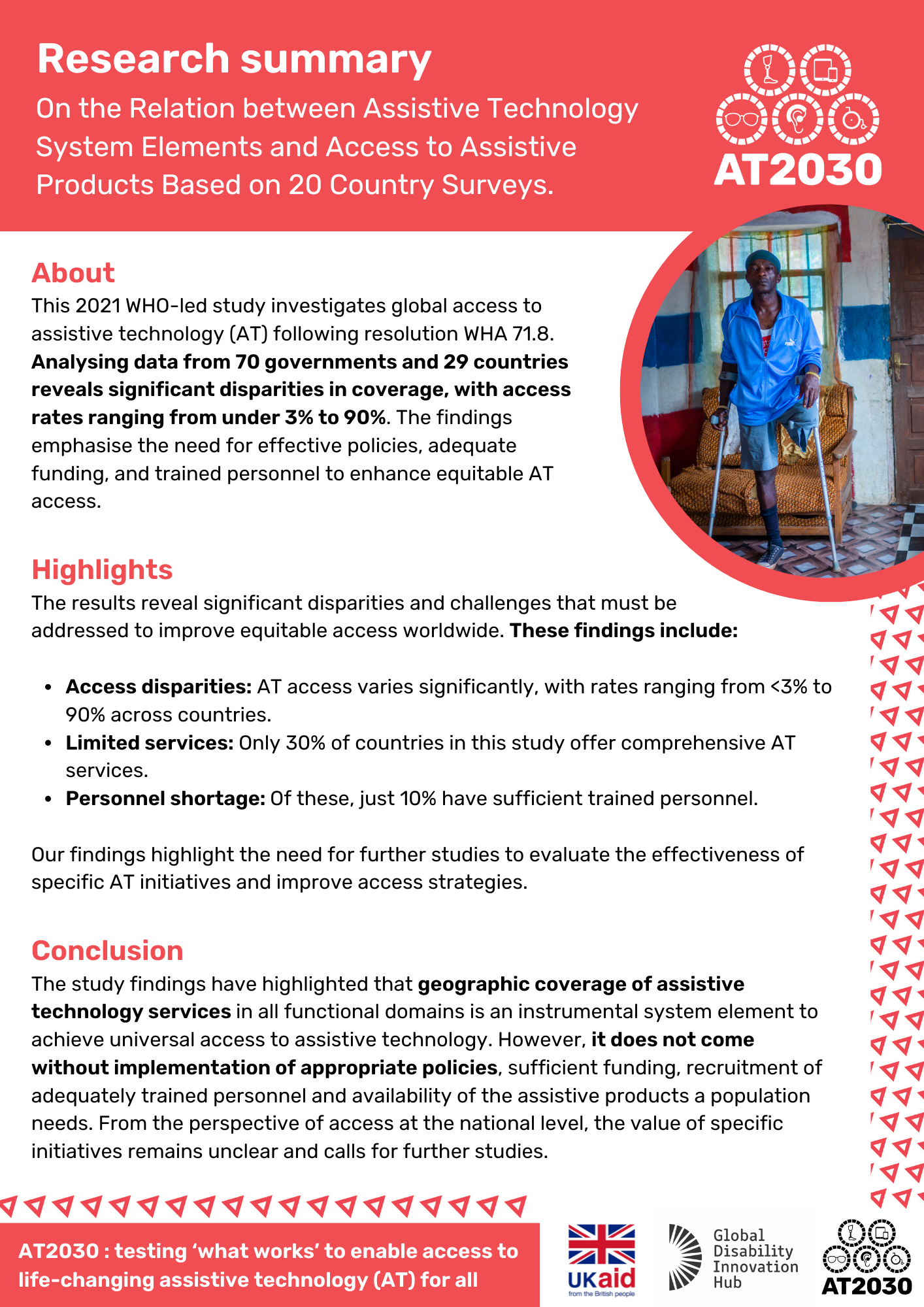
On the Relation between Assistive Technology System Elements and Access to Assistive Products Based on 20 Country Surveys - Research Summary
Wei Zhang, Johan Borg, Irene Calvo, Chapal Khasnapis, Mikael Winberg, Arne H EideNov. 1, 2024Research SummariesClick here to read a summary of the WHO-led 2021 study on global access to assistive technology (AT). The study reveals significant disparities in AT access, with rates ranging from less than 3% to 90% across countries. While many nations have AT policies, only 30% provide comprehensive services, and just 10% have sufficient trained personnel. Further research is essential to evaluate specific initiatives and enhance equitable access worldwide.
-
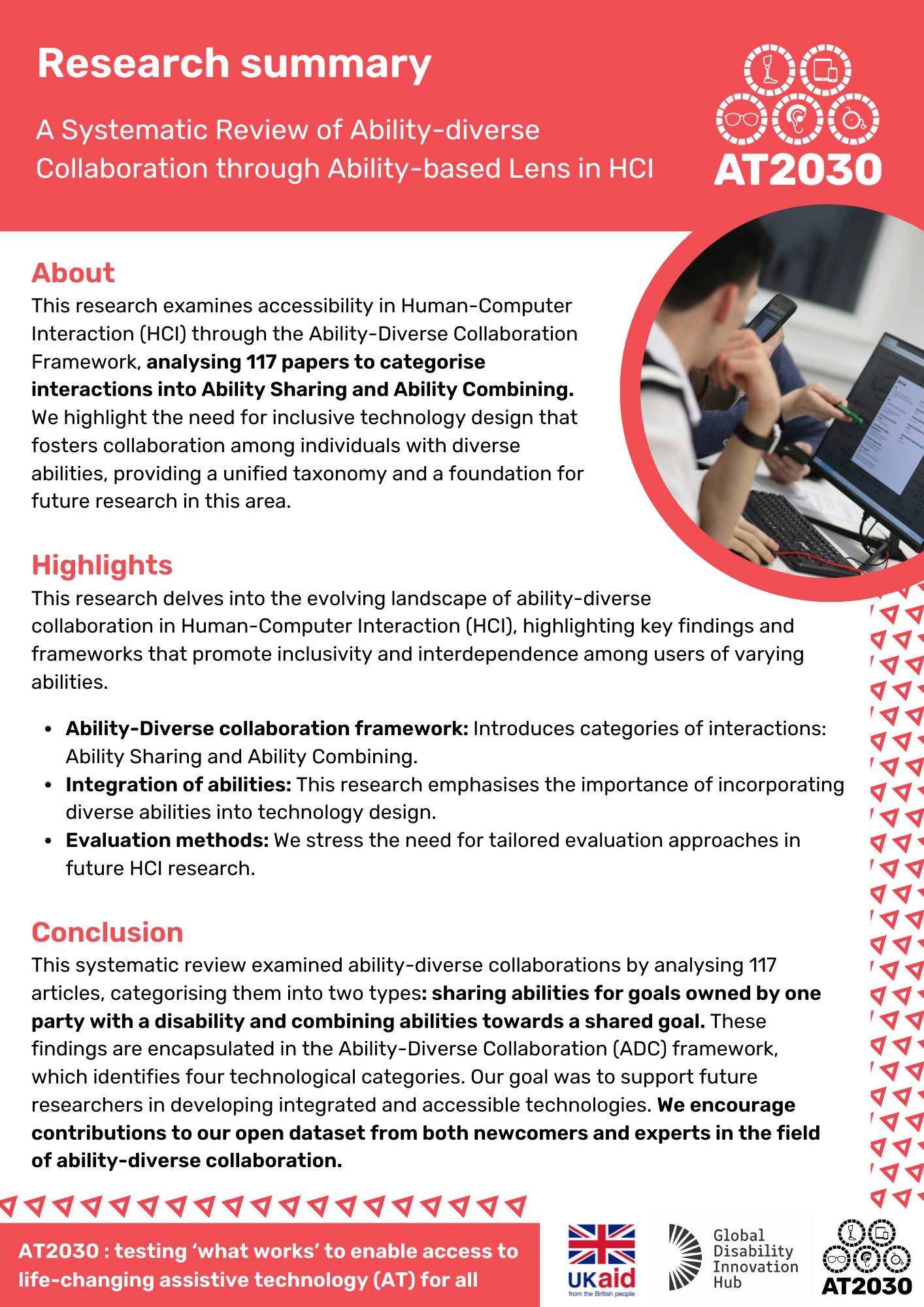
A Systematic Review of Ability-diverse Collaboration through Ability-based Lens in HCI Research Summary
Catherine Holloway, Lan Xiao, Katrin Angerbauer, Tigmanshu Bhatnagar, Weiyue Lin, Maryam Bandukda, Michael SedlmairNov. 1, 2024Research SummariesThis paper analyses 117 articles from the ACM Digital Library over the past two decades, offering (1) a unified taxonomy and the Ability-Diverse Collaboration Framework, (2) a reflective discussion of the current design landscape, and (3) insights into future research opportunities and challenges. We have also made our data and analysis tool available for contributions from the HCI research community.
-
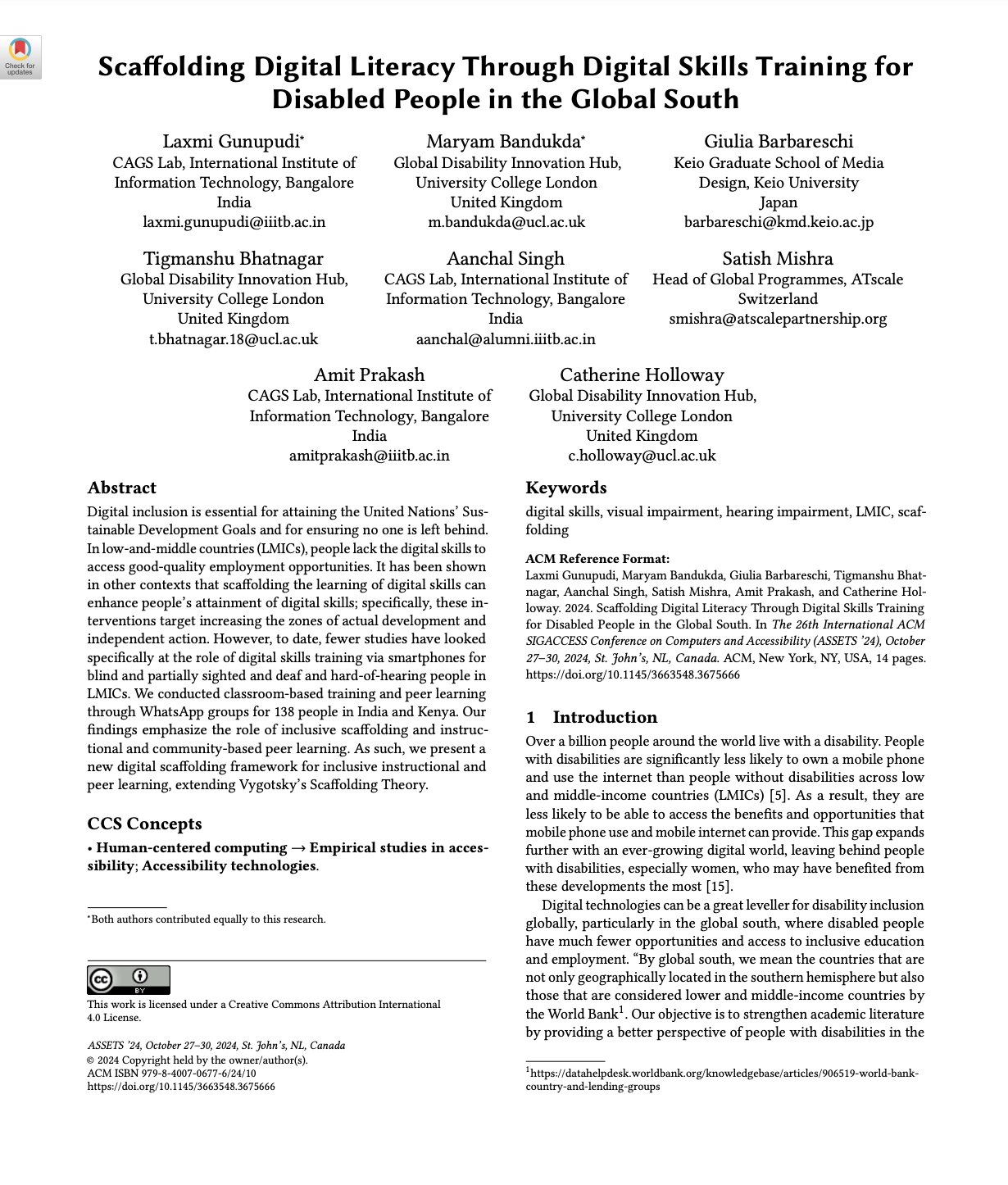
Scaffolding Digital Literacy Through Digital Skills Training for Disabled People in the Global South
Laxmi Gunupudi, Maryam Bandukda, Giulia Barbareschi, Tigmanshu Bhatnagar, Aanchal Singh, Satish Mishra, Amit Prakash, Catherine HollowayOct. 27, 2024Academic Research PublicationsDigital inclusion is key to the UN’s Sustainable Development Goals. In LMICs, limited digital skills hinder employment, especially for disabled individuals. Our study in India and Kenya trained 138 participants using classroom instruction and WhatsApp-based peer learning. We found that inclusive scaffolding and community-based learning are essential, leading to a new digital scaffolding framework extending Vygotsky’s Theory to enhance digital skills for all.
-
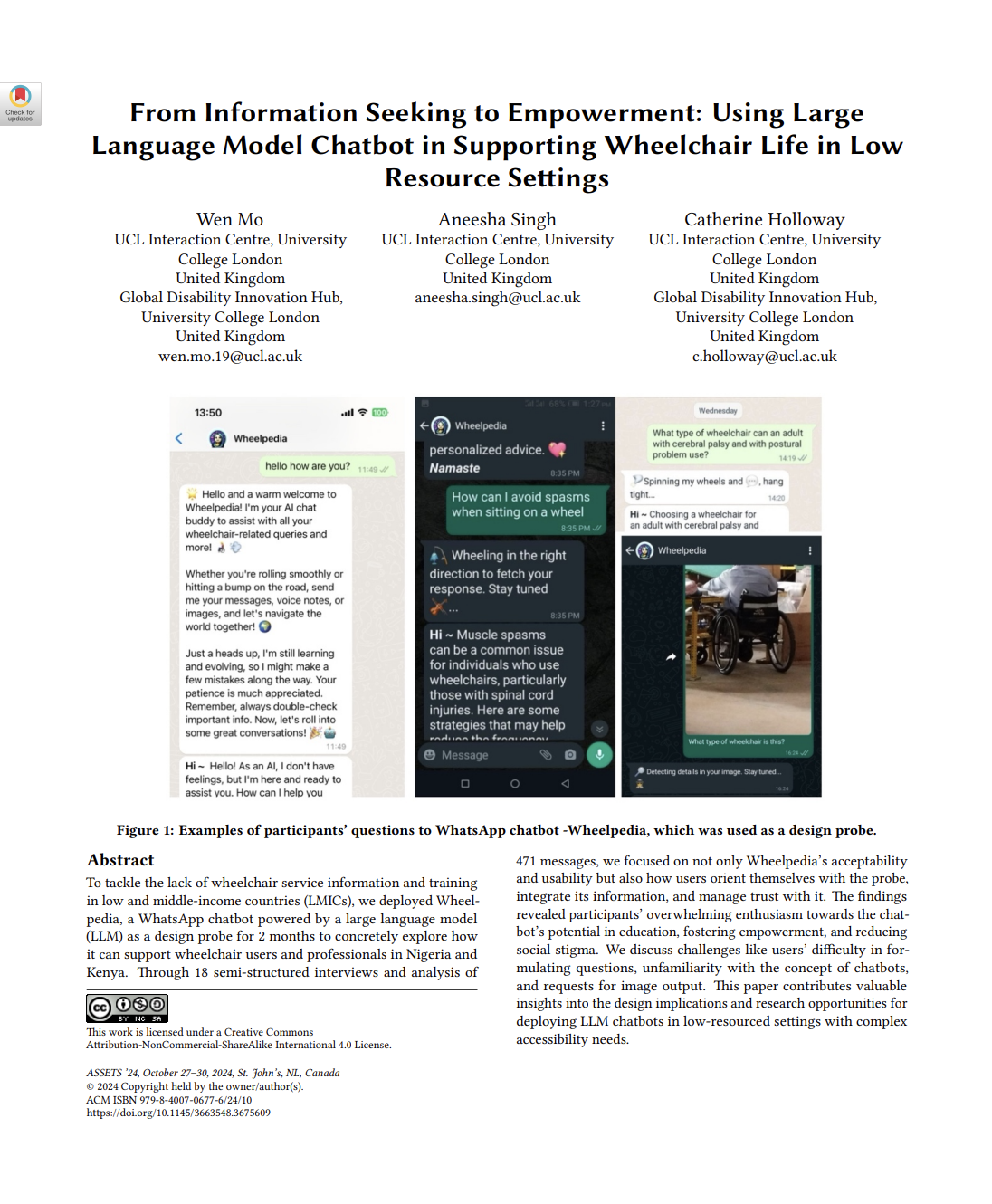
From Information Seeking to Empowerment: Using Large Language Model Chatbot in Supporting Wheelchair Life in Low Resource Settings
Wen Mo, Aneesha Singh, Catherine HollowayOct. 27, 2024Academic Research PublicationsWe deployed Wheelpedia, a WhatsApp chatbot, in Nigeria and Kenya to address wheelchair service gaps. Through interviews and message analysis, we explored its usability, trust, and impact on education and empowerment. Findings highlight challenges and opportunities for LLM chatbots in low-resource settings.
-
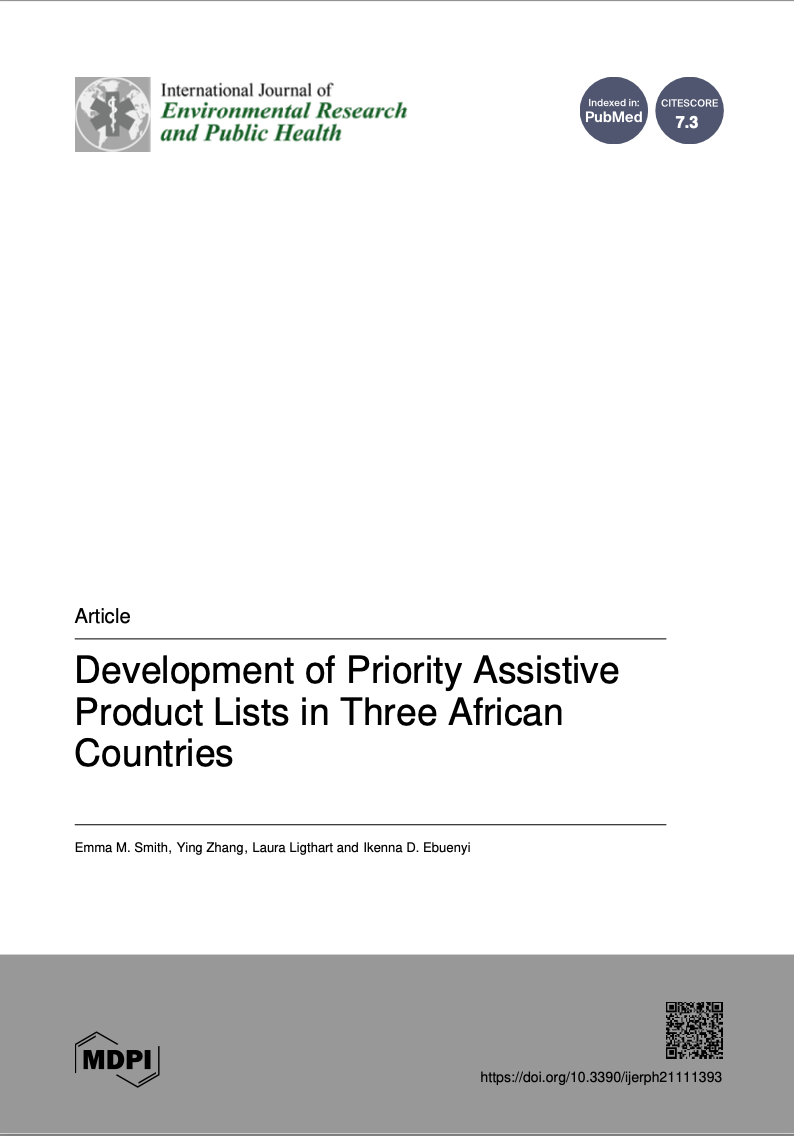
Development of Priority Assistive Product Lists in Three African Countries
Emma M. Smith, Ikenna D. Ebuenyi, Ying Zhang, Laura LigthartOct. 23, 2024Academic Research PublicationsNational Assistive Product Lists (APLs) are vital for improving access to assistive products, which enhance the well-being of people with disabilities and functional limitations. This study compares how the World Health Organization’s 5Ps model (people, personnel, policy, provision, products) influenced the development of national APLs in Malawi, Liberia, and Sierra Leone, aiming to improve assistive product service delivery.
-
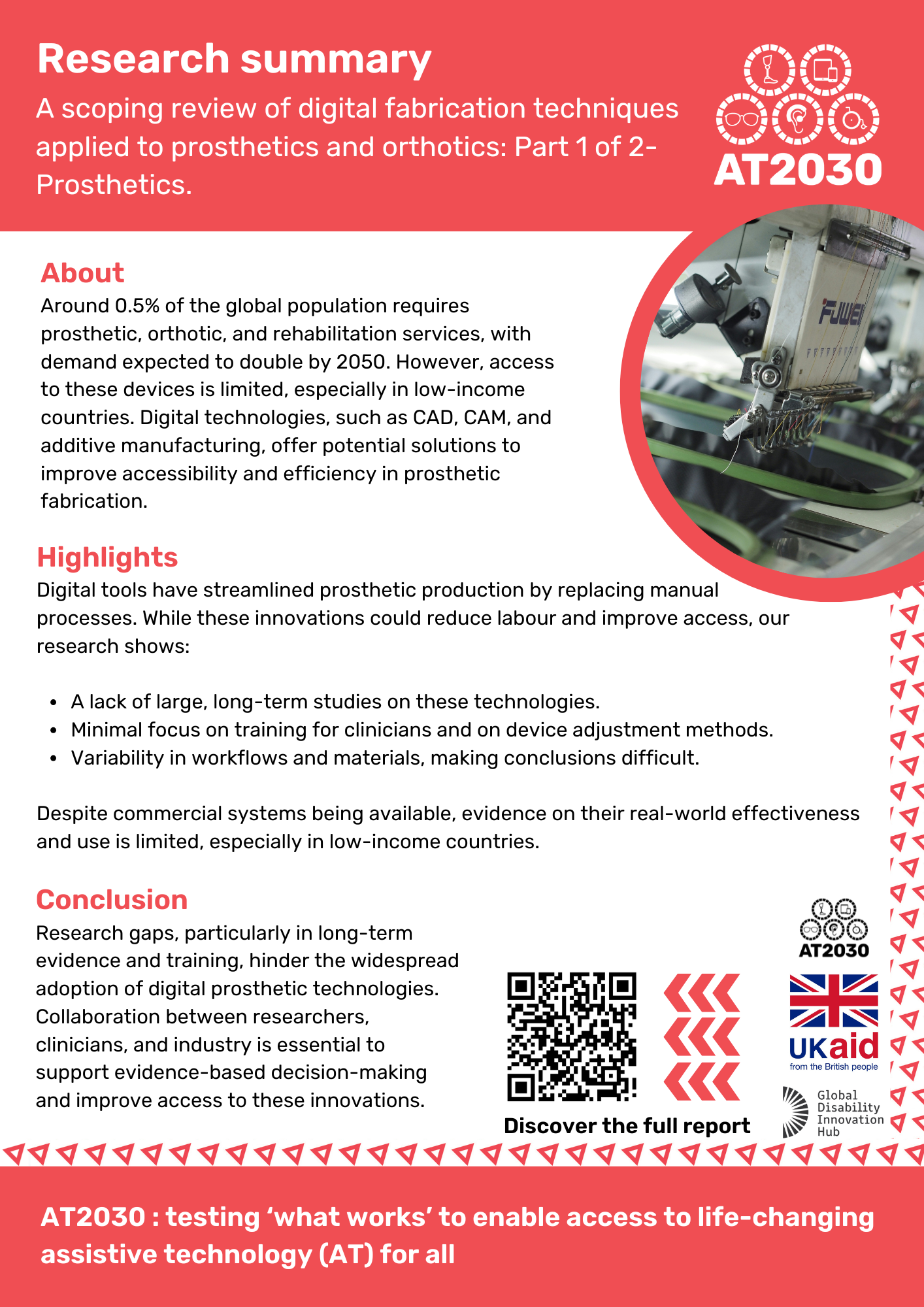
A scoping review of digital fabrication techniques applied to prosthetics and orthotics: Part 1 of 2-Prosthetics (Summary)
Dr Ben Oldfrey, Catherine Holloway, Margaret K Donovan-HallOct. 18, 2024GlobalResearch SummariesClick here to read a summary of our review on digital fabrication techniques applied to prosthetics and orthotics. Digital fabrication offers potential to improve global prosthetic access, but gaps in research, large-scale studies, training, and workflow standardisation hinder evidence-based adoption and practical implementation in real-world clinical settings.
-
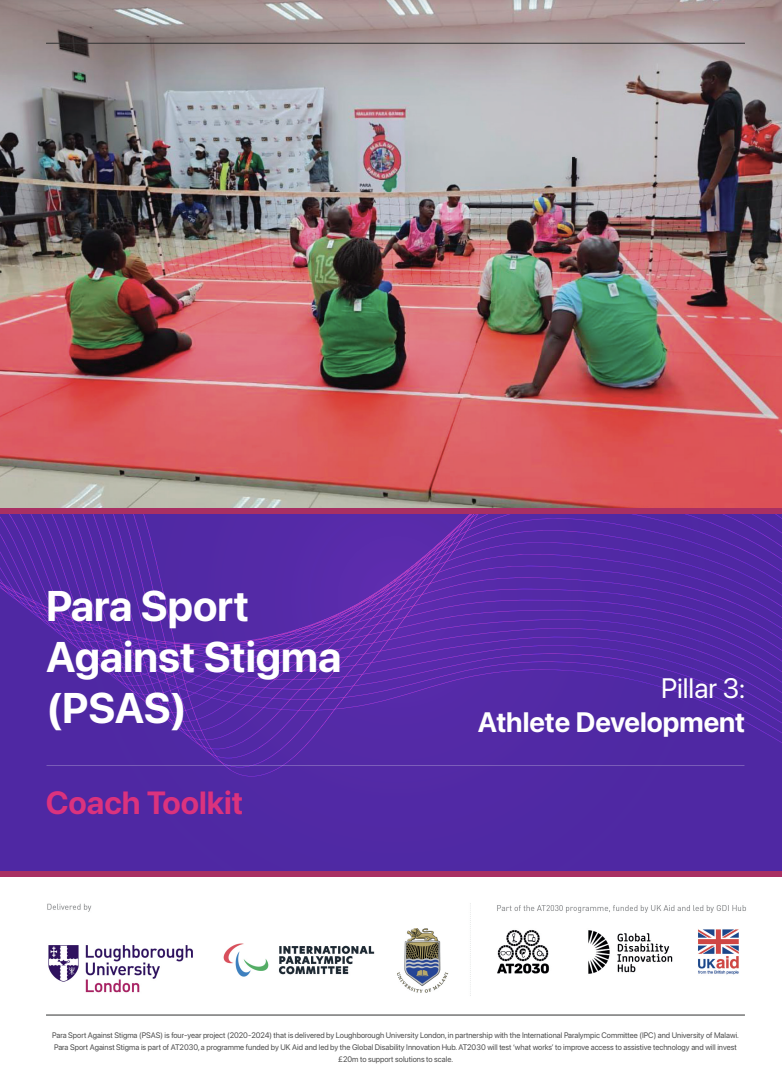
PSAS Coach Toolkit
Global Disability Innovation Hub, Loughborough University, The International Paralympic Committee (IPC), University of MalawiSept. 30, 2024MalawiAT2030 ResourcesThis toolkit is aimed at supporting coaches who work with disabled athletes within their national and international sporting systems. The toolkit is designed to provide useful information and step-by-step guides on important aspects of Para sport, such as classification systems and processes, competition requirements, coaching checklists and communication methods.
-
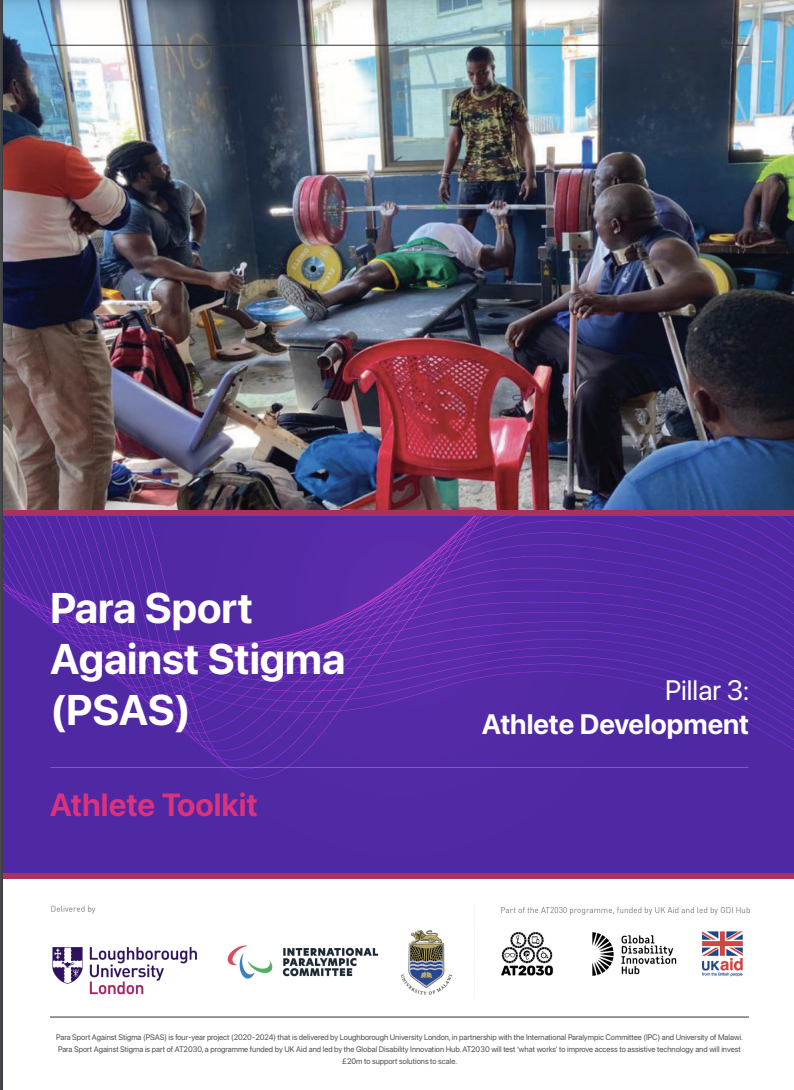
PSAS Athlete Toolkit
Global Disability Innovation Hub, Loughborough University, The International Paralympic Committee (IPC), University of MalawiSept. 30, 2024Ghana, Malawi and ZambiaAT2030 ResourcesThis toolkit is aimed at athletes with a disability who aspire to become world class and compete for their country at an international level. The toolkit is designed to provide useful information and step by step guides on important aspects of Para sport such as classification, competition, coaching and communication.
-
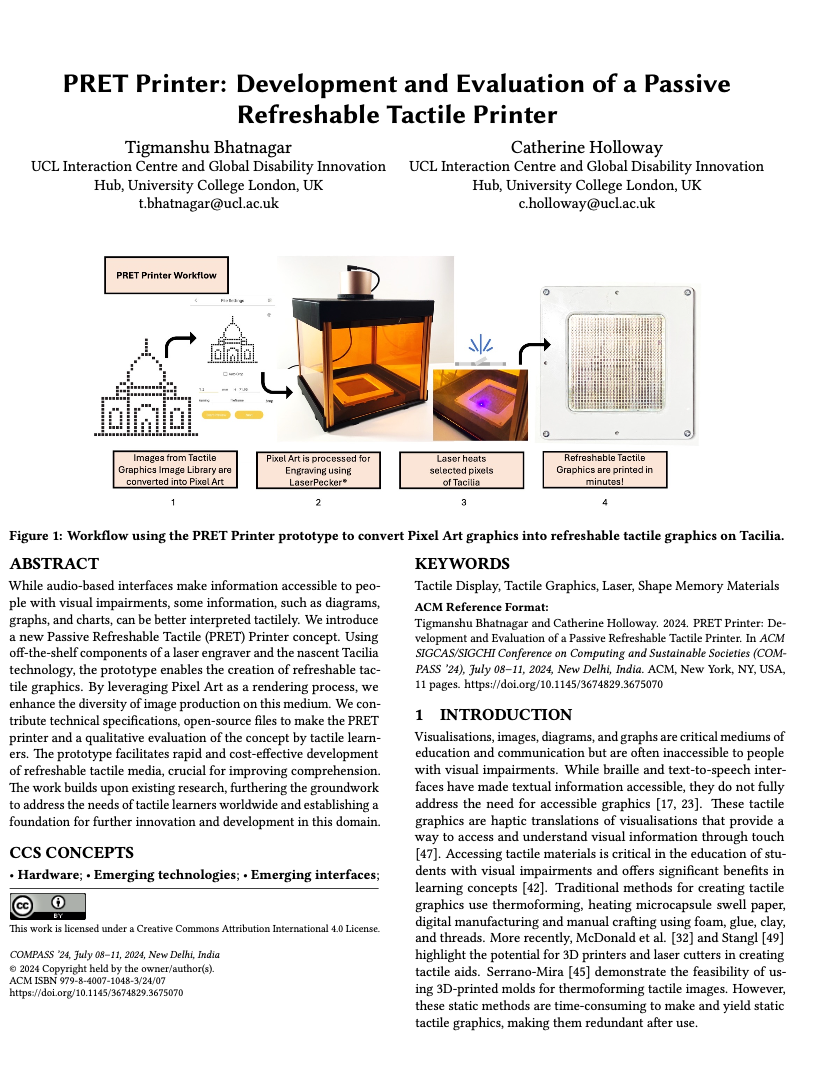
PRET Printer: Development and Evaluation of a Passive Refreshable Tactile Printer
Catherine Holloway, Tigmanshu BhatnagarAug. 28, 2024Academic Research PublicationsWhile audio-based interfaces make information accessible to people with visual impairments, some information, such as diagrams, graphs, and charts, can be better interpreted tactilely. We introduce a new Passive Refreshable Tactile (PRET) Printer concept. Using off-the-shelf components of a laser engraver and the nascent Tacilia technology, the prototype enables the creation of refreshable tactile graphics.
-
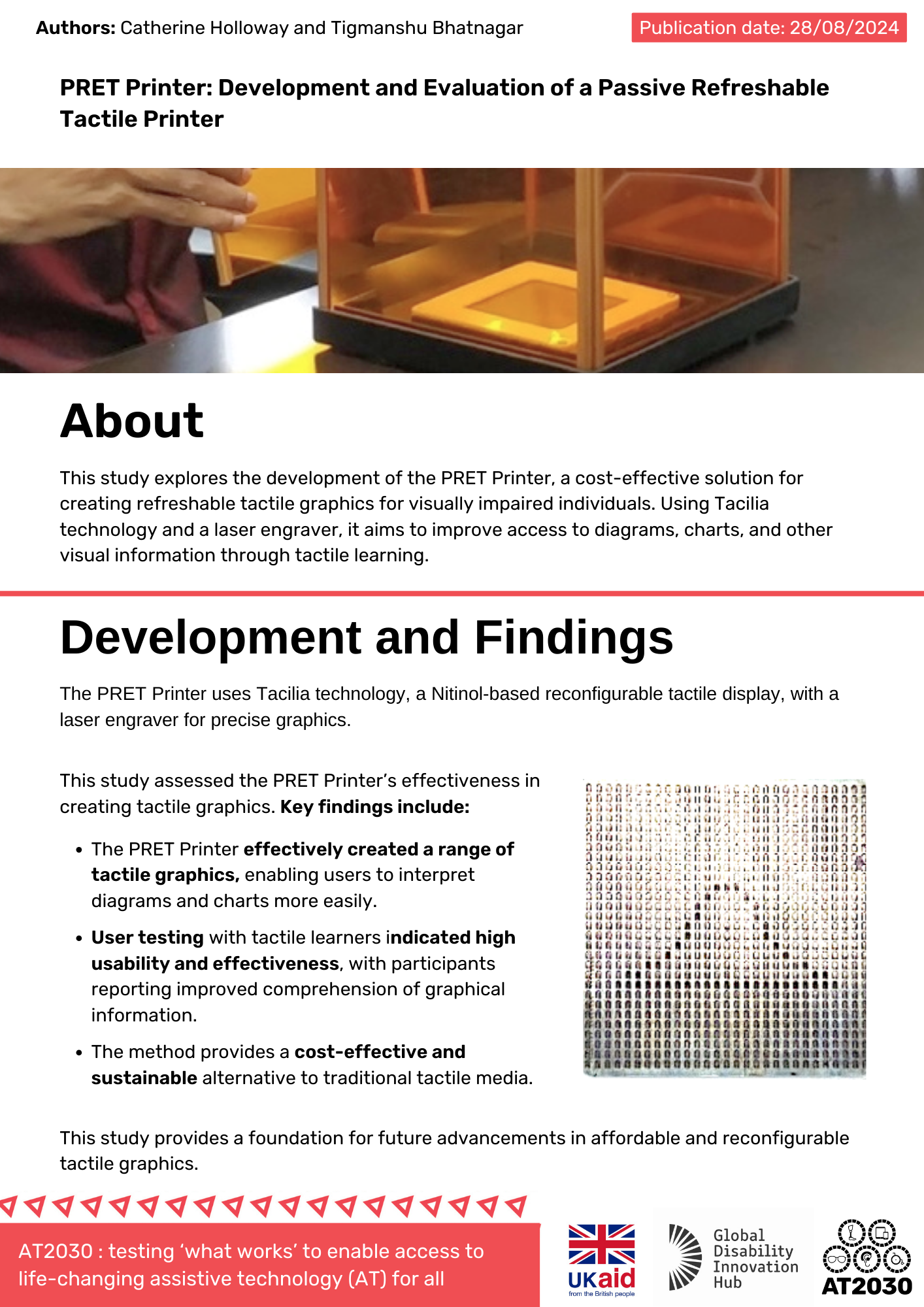
PRET Printer: Development and Evaluation of a Passive Refreshable Tactile Printer - Research Summary
Catherine Holloway, Tigmanshu BhatnagarAug. 28, 2024Research SummariesThe study explores the development of the PRET Printer, a cost-effective solution for creating refreshable tactile graphics for visually impaired individuals. Using Tacilia technology and a laser engraver, the system produces precise, reconfigurable tactile graphics. Testing showed high usability, with users reporting improved comprehension of diagrams and charts.
-
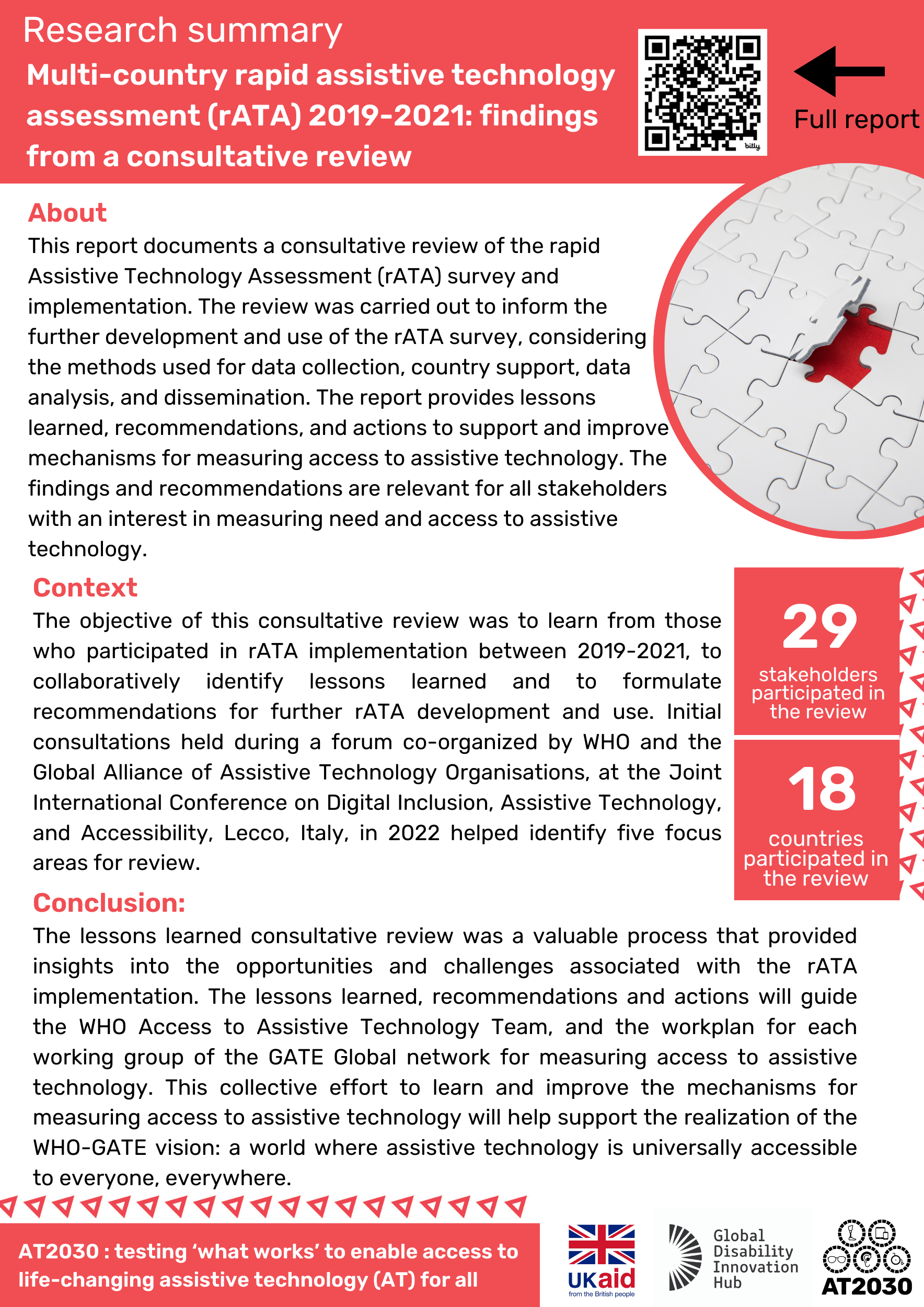
Research Summary: Multi-country rapid Assistive Technology Assessment (rATA) 2019-2021: findings from a consultative review
Global Disability Innovation Hub, World Health OrganizationJuly 25, 2024GlobalResearch SummariesThis research summary provides key highlights and snapshot content from the Multi-country rapid Assistive Technology Assessment (rATA) 2019-2021: findings from a consultative review.
-
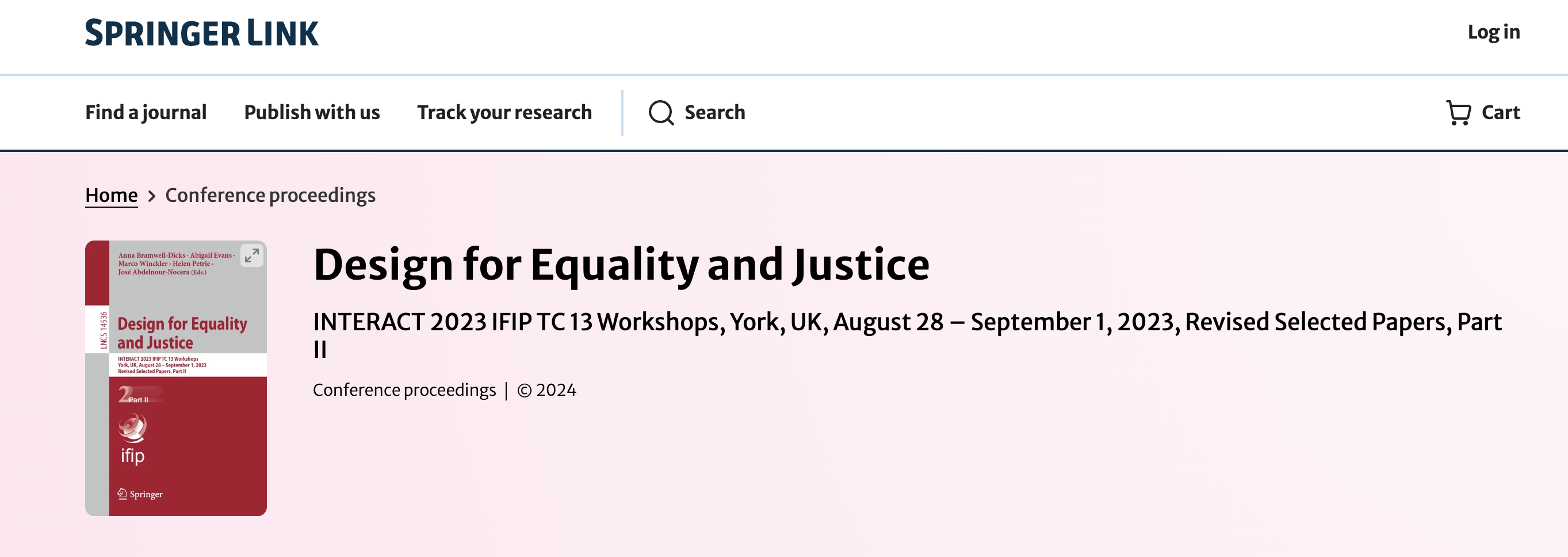
Mapping Assistive Technology Start-ups
Catherine Holloway, Tigmanshu Bhatnagar, Patel DilishaJuly 16, 2024GlobalAcademic Research PublicationsThis paper explored their experiences of providing and accessing AT, including procurement strategies, adoption of new technologies, and provision pathways. Overall, we found that there is still a substantial knowledge gap in assistive products, how to access products, and funding for needed products. These discussions also enlightened us that word-of-mouth and peer networks are the main avenues through which knowledge of assistive products is shared. Difficulties in keeping up with the expanding innovative landscape was raised as a key concern.
-
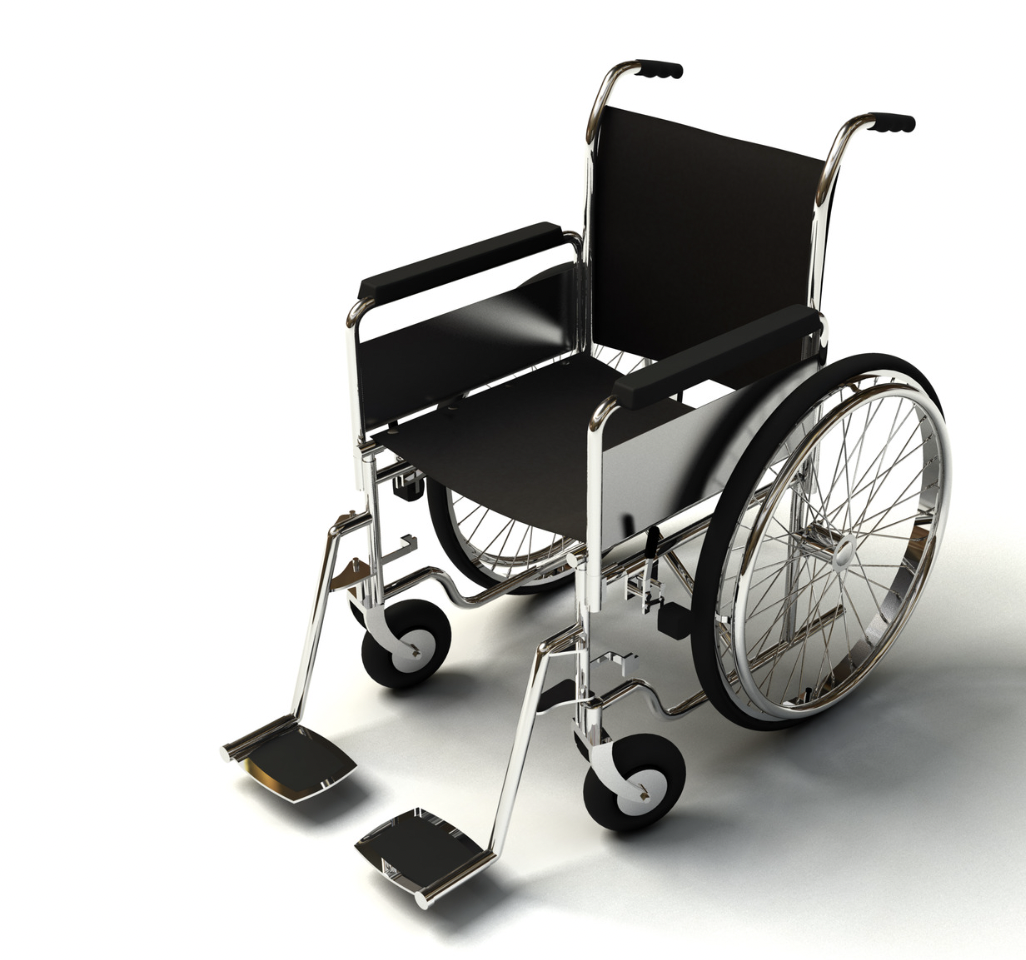
Exploring Information Needs for Tracking to Support Using Wheelchairs in Everyday Life
Wen Mo, Aneesha Singh, Catherine HollowayJuly 9, 2024GlobalAcademic Research PublicationsThis study contributes by delineating the unmet information needs in wheelchair tracking and advocating for more research interests to develop and design tracking tools in Human-Computer Interactions (HCI) that enrich the everyday experiences of wheelchair users.
-
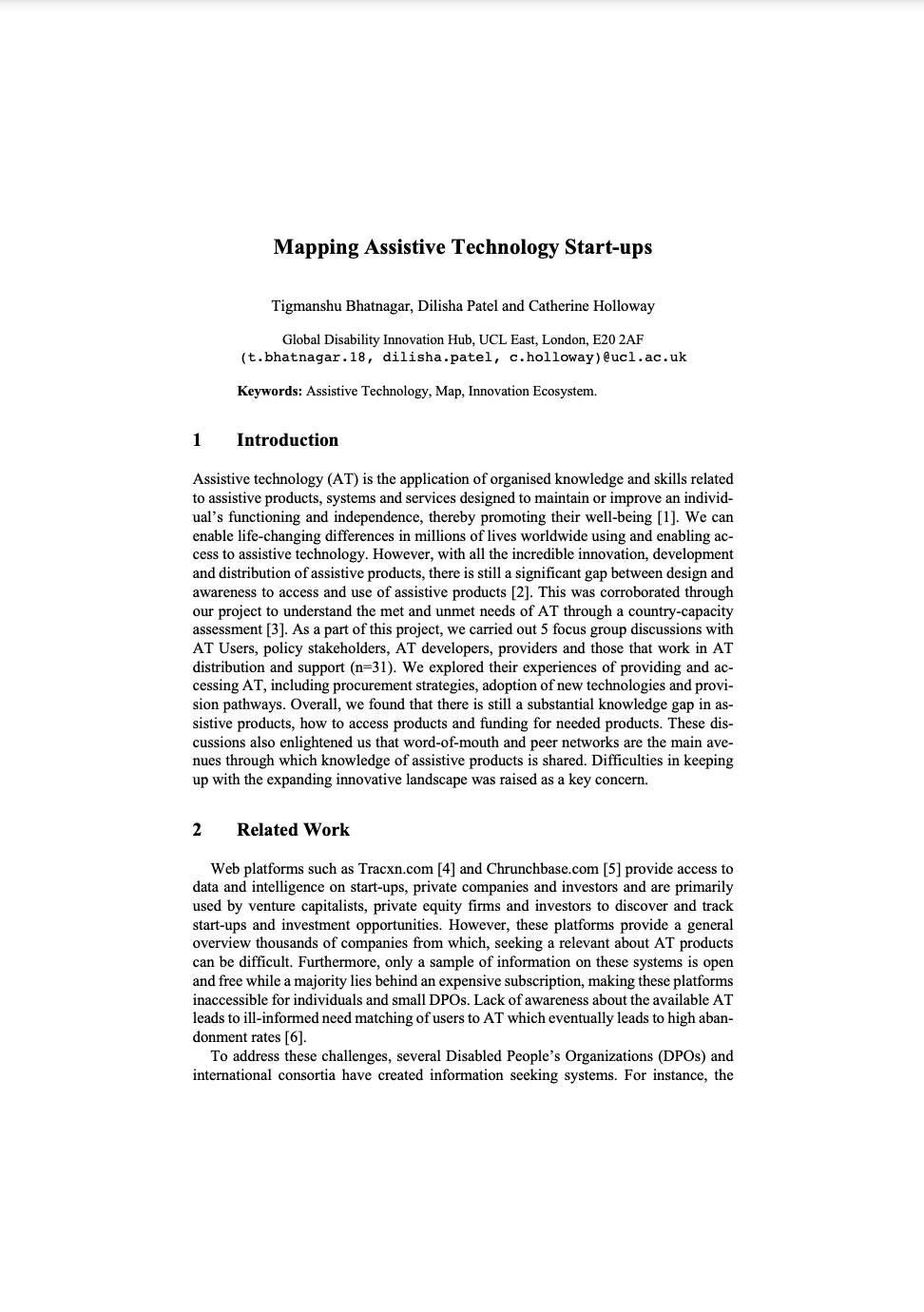
Mapping Assistive Technology Start-Ups (book: Design for Equality and Justice)
Catherine Holloway, Tigmanshu Bhatnagar, Dilisha PatelJuly 9, 2024AT2030 ResourcesThis project aimed to assess the met and unmet needs of AT through five focus group discussions with users, policy makers, developers, and providers. Findings revealed a major knowledge gap in accessing and funding assistive products, with word-of-mouth and peer networks being the primary sources of information.
-
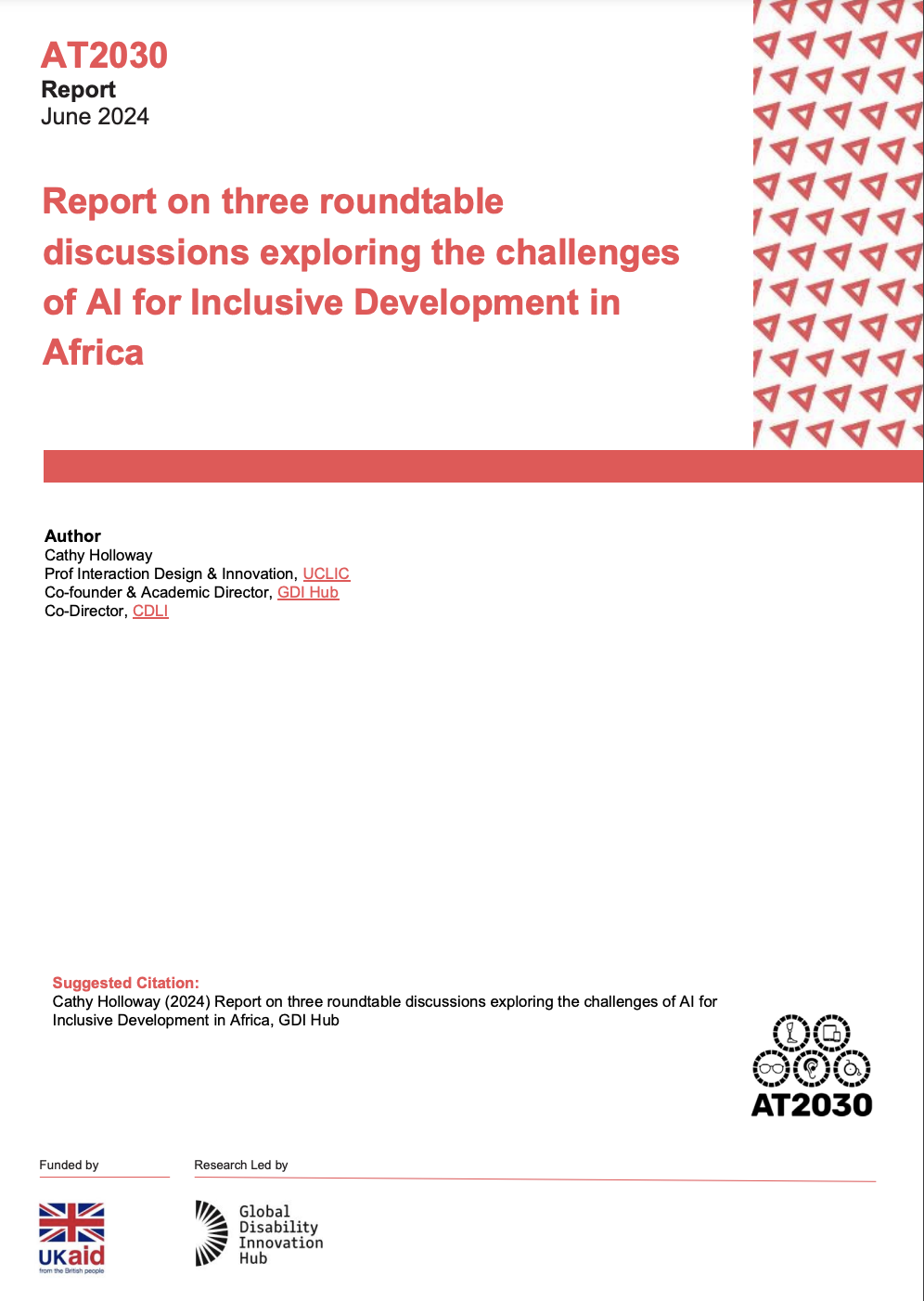
AI for Disability Inclusion in Africa
Global Disability Innovation HubJune 30, 2024AfricaAcademic Research PublicationsThis report summarises the opportunities, challenges and enablers for disability-inclusive AI in Africa and key research questions that were identified in three online roundtables held in February, March and April 2024. The roundtables were convened and hosted by UCL’s Global Disability Innovation Hub (GDI Hub) at the request of the Foreign, Commonwealth and Development Office (FCDO).
-
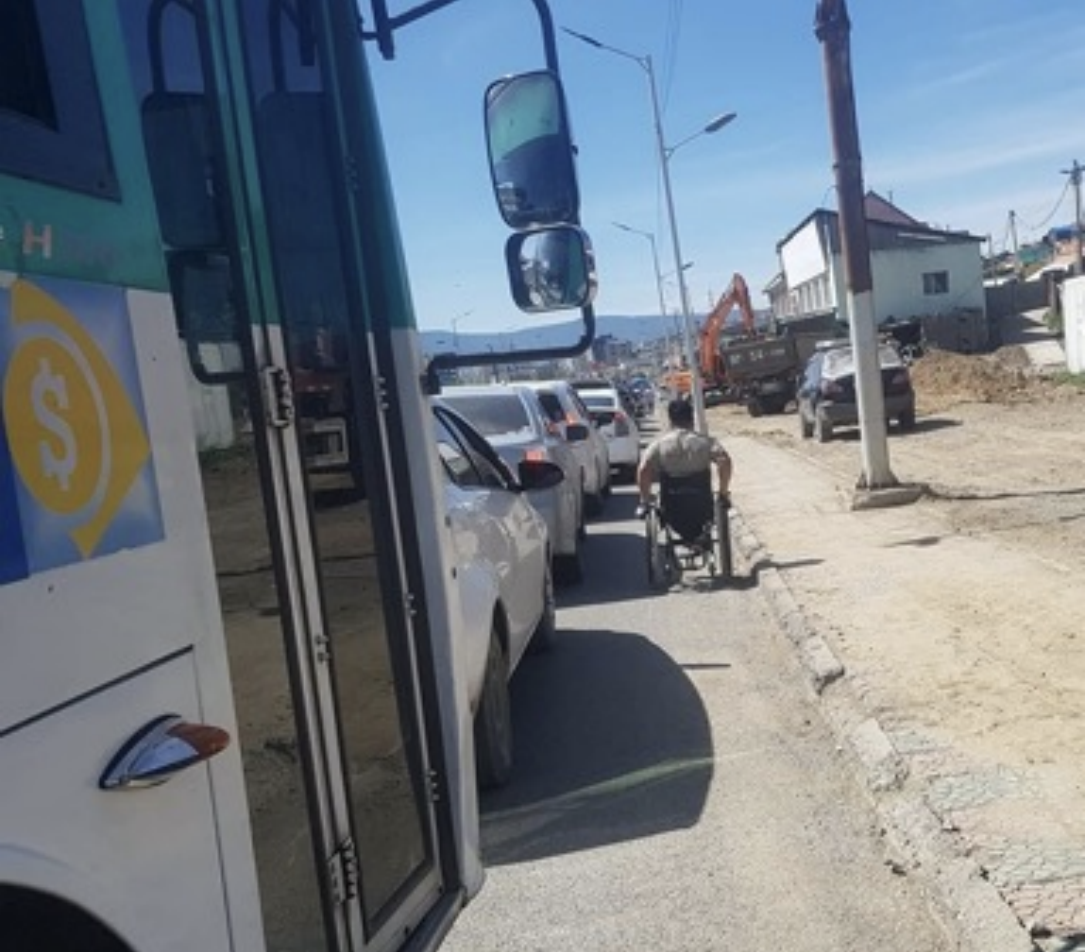
Collection of the AT2030 Inclusive Infrastructure case studies on Accessibility and Inclusive in the Built Environment.
Global Disability Innovation HubJune 13, 2024GlobalCase Studies and ReportsA collection of the case studies from the Inclusive Design and Accessibility of the Built Environment research.
-
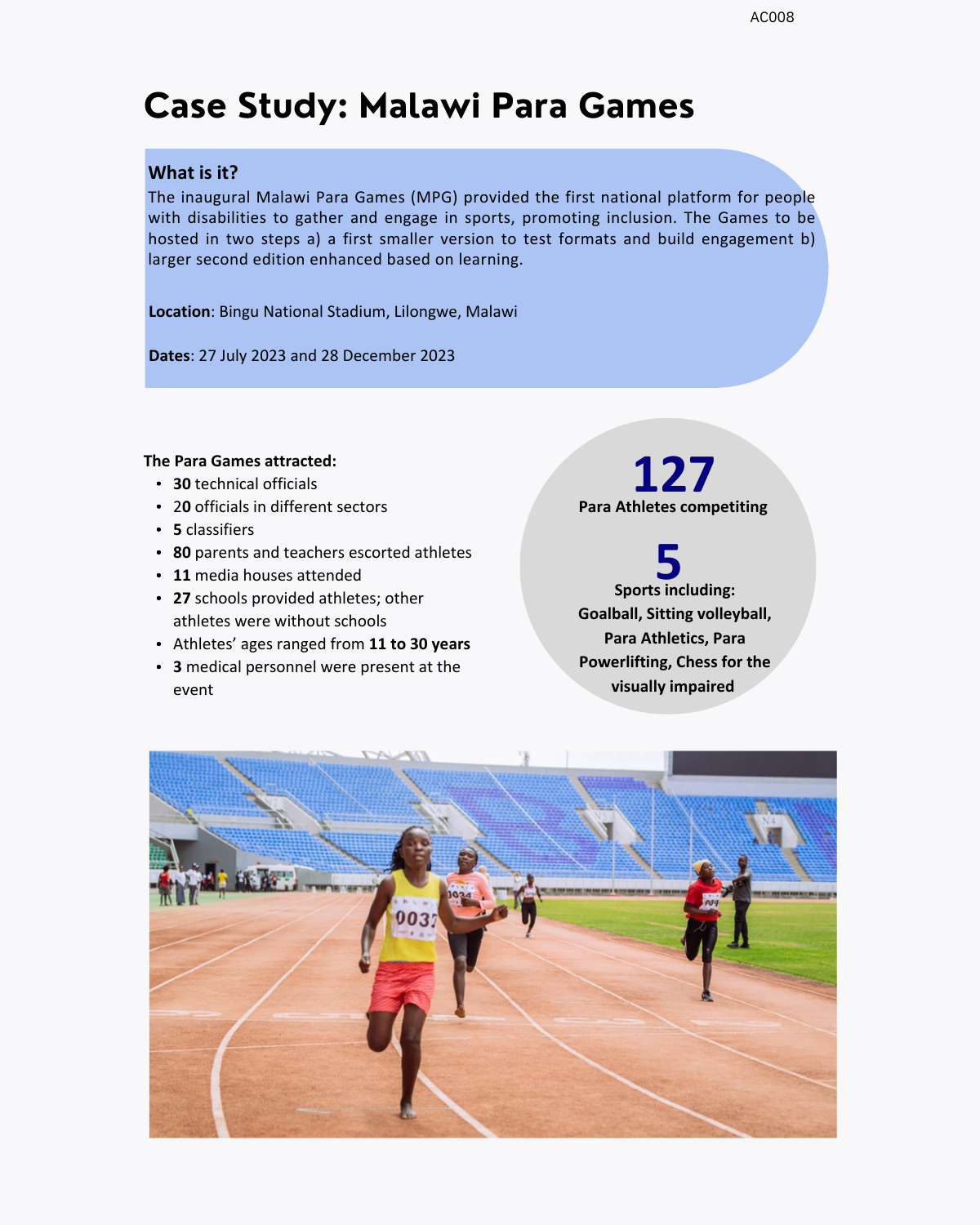
Case Study: Malawi Para Games
Global Disability Innovation HubMay 19, 2024MalawiCase Studies and ReportsThe Inaugural Malawi Para Games (MPG) provided the first national platform for people with disability to gather and engage in sports, promoting inclusion.
-
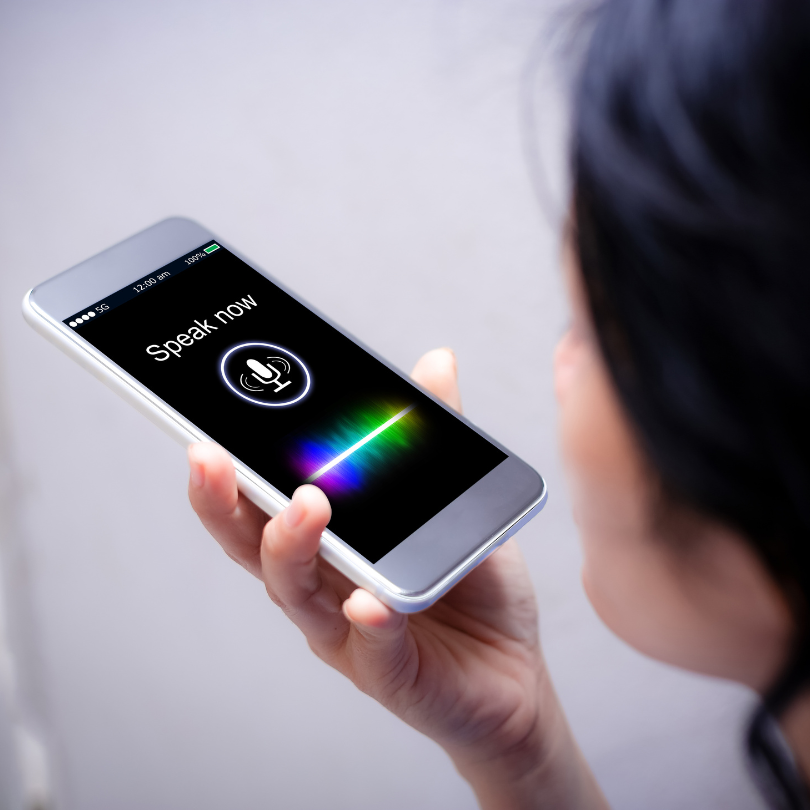
Enhancing Communication Equity: Evaluation of an Automated Speech Recognition Application in Ghana
Catherine Holloway, Giulia Barbareschi, Richard Cave, Gifty AyokaMay 11, 2024GhanaAcademic Research PublicationsIn Ghana people who struggle to articulate speech as a result of different conditions experience barriers in interacting with others due to difficulties in being understood. Automatic speech recognition software can be used to help listeners understand people with communication difficulties. However, studies have not looked at the practical feasibility of these technologies beyond the Global North. We present a novel user study examining the introduction of one such technology, Google Project Relate, to Ghana.
-
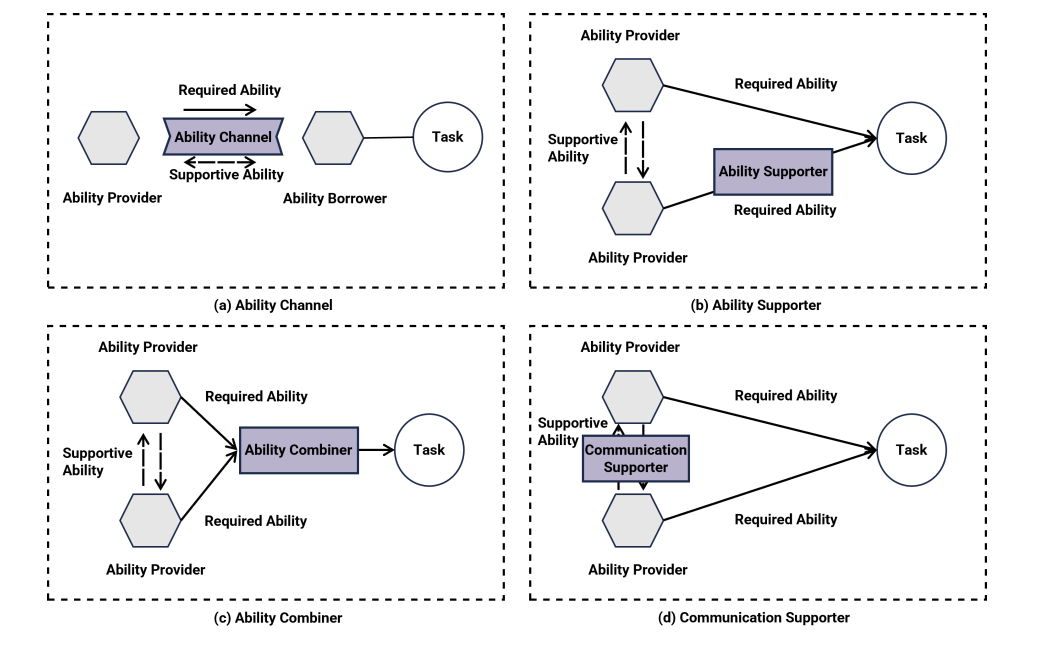
A Systematic Review of Ability-diverse Collaboration through Ability-based Lens in HCI
Catherine Holloway, Tigmanshu Bhatnagar, Maryam Bandukda, Lan Xiao, Katrin Angerbauer, Weiyue Lin, Michael SedlmairMay 11, 2024GlobalAcademic Research PublicationsThis paper offers an analysis of 117 papers sourced from the ACM Digital Library spanning the last two decades. It contributes (1) a unified taxonomy and the Ability-Diverse Collaboration Framework, (2) a reflective discussion and mapping of the current design space, and (3) future research opportunities and challenges. Finally, we have released our data and analysis tool to encourage the HCI research community to contribute to this ongoing effort.
Previous PageNext Page